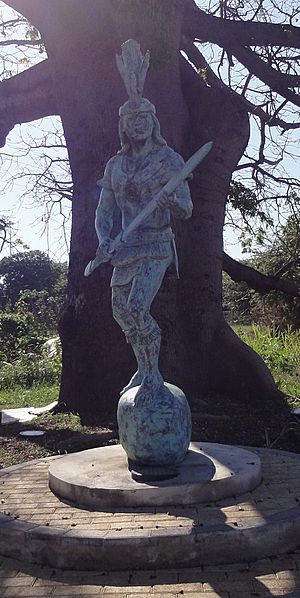Caciques in Puerto Rico facts for kids

The native Taíno people were very important in the history and culture of Puerto Rico. They lived on the island long before others arrived. Each Taíno group had a special leader called a cacique. These caciques, along with other important people called nitaínos, helped govern their villages. These villages were known as yucayeques.
Contents
Who Lived on the Island First?
Scientists believe the first people to settle in the Caribbean, including Puerto Rico, were the Ortoiroid. This small group traveled from Venezuela to Trinidad and Tobago around 5,000 BC. After them came the Casimiroid people from Central America. Several other groups lived on the island before the Taíno people became the main inhabitants many hundreds of years later.
Taíno Society: Who Was Who?
The Taíno people of Puerto Rico lived in villages called yucayeques. These villages were spread all over the island. Taíno society had different levels of importance:
- Naborias: These were the common people. They did most of the work, like hunting, preparing food, and building homes called bohíos. Some historians think naborias might have been descendants of earlier groups or less powerful families.
- Nitaínos: These were the nobles, or important people. They helped manage the naborias and also led them during battles.
- Caciques: At the very top were the caciques. They were not just leaders of the village; they were also important religious figures. Caciques usually had full control over their yucayeques. Sometimes, if a region had many villages, a cacique might answer to a "supreme cacique."
Caciques and Puerto Rican History
Caciques played a huge role in the history of Puerto Rico. This was especially true when the Spanish arrived on the island. In 1508, when the Spanish first came, there were an estimated 20,000 to 50,000 Taíno people living there.
At first, the Taíno people were very welcoming to the Spanish. They thought the Spaniards might be spiritual beings. The Spanish took advantage of this kindness. They made the Taíno people work hard to find gold and do other labor. The Spanish also introduced a system called encomienda. This system gave Spanish settlers control over Taíno land and labor. Because of this unfair treatment, the caciques and the Taíno people lost control of their island.
The Taíno Rebellion
The Spanish treated the Taíno people very poorly, and the Taíno population began to shrink. Because of this, a brave cacique named Agüeybaná II became the head cacique after his brother, Agüeybaná I, passed away. Agüeybaná II was not sure if the Spaniards were truly spiritual beings.
To find out, Agüeybaná II and another cacique named Urayoán planned an ambush. They targeted a Spanish soldier named Diego Salcedo as he tried to cross the Río Grande de Añasco river. The Taíno people drowned the soldier. They then watched his body for three days. They were afraid he might come back to life. When they saw that he was truly mortal, the Taíno people declared war on the Spanish. This led to the Spanish–Taíno War of San Juan–Borikén.
Many Taíno caciques led their people in this rebellion. These leaders included Agüeybaná II, Urayoán, Coxiguex, Jumacao, Loquillo, Orocobix, and many others. However, the Taíno people did not have the same weapons as the Spanish. Sadly, the Taíno were defeated. Their numbers greatly decreased due to illnesses brought by the Europeans and the harsh conditions they faced.

